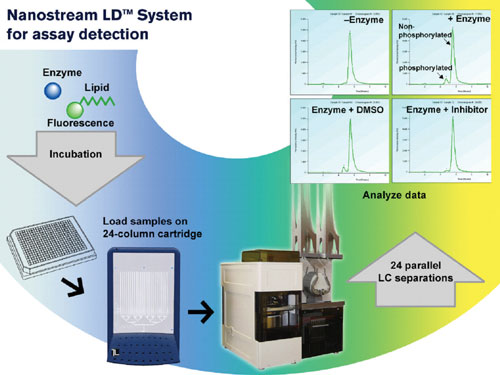December 1, 2007 (Vol. 27, No. 21)
Application of Nanostream LD System for the Development of a Diverse Range of Bioassays
During the last 50 years, an abundance of data has been gathered on the function of lipids as a source of energy, as building blocks, and as signaling molecules in living systems. Lipid-signaling plays a crucial role in biological processes with relevance for several therapeutic areas such as metabolic diseases, cancer, and pain regulation.
Throughout the course of the Human Genome Project, dozens of genes encoding novel variants of lipid-modifying enzymes such as lipases, acyltransferases, and lipid kinases have been discovered. While kinases represent a significant target class in current drug discovery today, it is projected that lipid-modifying enzymes will be of similar importance during the next few years.
Every major pharmaceutical research organization has started to conduct early-stage discovery initiatives using lipid-modifying enzymes as pharmacological targets for identifying hits and lead compounds of therapeutic relevance.
At this early stage, considerable attention has been devoted to enzyme-catalyzed chemical modifications of biolipids such as lipid-cleavage, chain elongation, lipid-phosphorylation, dephosphorylation, and acyl-chain desaturation. However, the conventional assay-development process for lipid-modifying enzymes is time consuming and tedious.
Separation-based Approach
By employing a separation-based assay detection platform, researchers can successfully develop challenging assays for lipid-modifying enzymes in a rapid time frame. This approach allows researchers to measure the activity of enzymes with low kinetic activity and enzymes that cannot be analyzed on existing platforms. Compared to conventional plate-based assay technologies, separations allow for quantitation of each component and are less prone to interferences, yielding a greater degree of certainty in the result.
The separation-based approach offers greater flexibility in attaching a tag anywhere on a substrate, which, in turn, speeds development time. Also, separation-based assays provide ratiometric analysis of substrate to product, which allows sensitive detection of low conversion levels, thus ideal for real-time kinetics.
Based on microparallel liquid chromatography (µPLC), Nanostream (www.nanostream.com) developed the Nanostream LD System, a detection platform for assays throughout the screening process—from target characterization through to lead optimization. µPLC miniaturizes liquid chromatography by enabling 24 simultaneous separations and real-time UV and fluorescence detection. By operating in a truly parallel fashion, µPLC allows for the analysis of more samples in less time, which eliminates throughput bottlenecks.
With the Nanostream LD System, researchers can analyze a large number of compounds, increase the number of replicates or conditions used in a study, and reduce solvent consumption and mixed waste generation. Also, the Nanostream LD System integrates with existing workflow and employs commercially available reagents and consumables.
The Nanostream LD System is ideal for developing and screening lipid-modifying enzyme. Method development is simple and iterative with the Nanostream LD System since researchers can optimize conditions for enzyme assays quickly and in parallel, thereby shortening the assay-development time from months to days while achieving higher quality data. By analyzing 24 samples simultaneously, researchers can employ a matrix-based, multiparameter testing approach to define optimal concentrations of buffer constituents, substrates, co-factors, and incubation times.

Figure 1
Investigating Lipid Substrates
Each reaction mixture is aspirated from a microtiter plate well, using the integrated autosampler, and injected onto a column in the Nanostream 24-column microfluidic Brio cartridge (Figure 1). Then, the lipid substrate and its resultant product are separated via µPLC. The system’s integrated analysis software provides fast and accurate ratiometric readout.
In the first example, a separation-based assay was developed for phospholipase A2. Phospholipase A2 proteins are responsible for the release of arachidonic acid from membranes, and the subsequent conversion of this fatty acid to leukotrienes and prostaglandins is part of the inflammatory response. The enzyme in this assay was emulsified (vesicle-based), and the substrate was incubated with PLA2 enzyme. After subsequent analysis with µPLC, the Nanostream LD System enabled monitoring of the substrate, product, and by-product.
A second example is a screening assay for sphingomyelinase developed for µPLC. This is a class of enzymes that catalyzes the hydrolysis of sphingomyelin. These enzymes are also lacking in some metabolic deficiency diseases (e.g., Niemann-Pick disease) in which sphingomyelin accumulates in bodily organs (e.g., the spleen and liver). Sphingomyelinase assays are complex because the enzymatic reaction needs to be conducted using an enzyme that is incorporated in a micelle formulation.
Finally, a PI3 kinase assay was developed using the Nanostream LD System. PI3 kinase is at the epicenter of one of the major pathways of intracellular signal transduction. The enzyme products are implicated in a wide variety of cellular functions including cell growth, differentiation and survival, glucose metabolism, and cytoskeletal organization.
In several tumor types, PI3 kinases become over-activated because tumor suppressors such as PTEN (phosphatase and tensin homologue deleted on chromosome ten) lose their function. In the assay developed by Nanostream, the substrate was incubated with PI3 kinase, and the samples were analyzed using the Nanostream LD System. As indicated, the system can offer linear detection over the entire physiological concentration range (Figure 2).

Figure 2
Conclusion
Lipid-modifying enzymes represent a target class of growing interest for drug discovery in biotech and pharma. While there is no dominating assay technology for the study of these diverse enzyme targets, the separation-based approach to developing assays offers several strong advantages for screening and confirmation of early-stage inhibitors directed toward these enzymes.
Jonas Ekblom, Ph.D., is COO,
Jun Wu, Ph.D., is product manager of biochemical assays, Jeff Koehler, Ph.D., is principal scientist, and Elizabeth Rietz is director of marketing at Nanostream. Web: www.nanostream.com.
Phone (626) 351-8200.
E-mail: [email protected].



